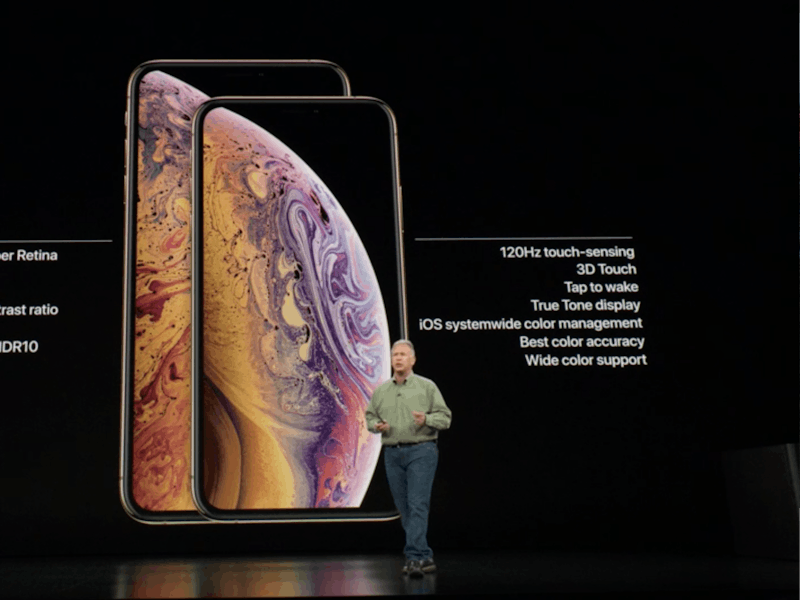iPhone XS vs iPhone XS Max: How Their Prices, Features, and Specs Stack Up
Which one should you cop?

There are plenty of smartphone users for whom bigger is always better, and they must have been particularly pleased on Wednesday as Apple rolled out its biggest iPhones yet (with a record-setting price tag to match). But are these two magnificent lads, the iPhone XS and iPhone XS Max, worth the extra money?
These two premium releases build upon the signature notched-screen design and Face ID unlock feature that were debuted with on the iPhone X. These features are advanced by an arsenal of next-generation tech that comes packed into every square inch of these handsets.
Record-setting storage space, for example, gives users laptop-like room for pictures, videos, and music. Eye-popping displays bring the shows you watch and the games you play to life in the palm of your hand. And improved battery life ensures you can keep browsing, tapping, and swiping longer than you could with the the iPhone X.
This year’s Apple smartphone launch was full of firsts for the company, including its most major foray into healthcare tech yet. But as for the iPhones, the changes at first pass can seem pretty incremental, which begs the question, should you be amongst the first to pick one up?
One touted feature is the iPhone XS's new, more water resistant finish.
iPhone XS vs iPhone XS Max: How Much Space Can I Get For My Money?
Both the XS and XS Max come in three price tiers determined as usual by the storage space. For the first time in iPhone history, Apple is offering 512GB of storage space for its two high-end smartphones.
That’s enough to hold up to 200,000 photos, according to the company’s claims. To even come close to using that up within in a year, you’d have to take roughly 548 pictures a day. So you can pretty much forget about having to clear your phone of videos and images after a vacation.
As we’ve written before, that’s a ton of storage: There are currently Google Pixelbooks on the market with comparable storage capability. This makes the 512GB geared towards smartphone power users who enjoy constantly snapping pictures, capturing high-definition video, and mobile gaming.
As for the price? The baseline 64-gigabyte XS will set you back $999 and the 64GB XS Max will go for $1,099. The middle-of-the-road option for each phone will get you 256GB of room, which will be priced at $1,149 for the XS and $1,249 of the XS Max. The 512GB variants will set you back a pretty penny, the XS model clocks in at $1,349 and the XS Max will retail for an eye-watering $1,449.
iPhone XS vs iPhone XS Max: Dazzling Displays
It’s probably the first thing you noticed about the handset duo, but their screens are stunning. The XS comes with a 5.8-inch OLED display with 2,436 x 1,125 resolution — just like the iPhone X — but the XS Max could be the granddaddy of all smartphones this year. The larger model comes swinging with a 6.5-inch OLED screen with 2,688 x 1,242 resolution, the biggest screen to ever be featured on an Apple smartphone.
If you’re one to watch Netflix on the go or play immersive games, you that XS Max might be up your alley. But if you’re satisfied with the screen real-estate of the iPhone X and are considering an upgrade, the XS could be the move.
iPhone XS vs iPhone XS Max: Battery Life Improvements
There’s nothing more annoying than having to stay tethered to a wall while you wait for your phone to charge. But both of these new releases are said improve upon the iPhone X’s battery life.
Give or take, last year’s flagship had a battery life of 21 hours. While Apple doesn’t list the milli Amp hour (mAh) specs of the batteries at the heart of the XS and XS Max, the former is said to last 30 minutes longer than the iPhone X while the latter can last up to an hour and a half longer than the last year’s flagship. That means, using some back of the envelope math, that both last roughly 21 hours and 30 minutes and 22 and 30 minutes respectively.
If you find yourself constantly running low, the XS Max might be what you’re looking for, but if you’re good at managing your juice then the smaller version will probably suit you. Either way, both of these phones have fast-charge capabilities, which should allow them to get to 50 percent charge in about 30 minutes.